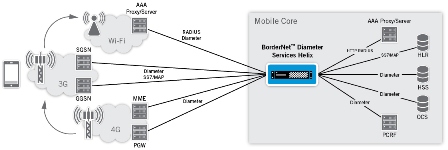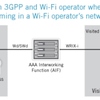
In my last blog, I discussed the architectures needed to roam between Wi-Fi and 3G/4G networks. In order to enable interoperability between the different architectures, a mediation and interworking platform is required to support the different scenarios in which RADIUS, Diameter and SS7 are used.
RADIUS is critical for interworking with Wi-Fi networks. Authentication and authorization of roaming subscribers is performed through RADIUS messages over an inter-operator interface between the visited network provider and home service provider. The interface can be implemented directly between two operators or through an intermediary, such as an internetwork packet exchange (IPX) or wireless roaming intermediary exchange (WRIX) provider. The interworking functionality can be placed within the visited network, the home operator’s network, an IPX/WRIX provider or all three locations.
While most of the authentication and authorization traffic is RADIUS-based, many 3rd Generation Partnership Project (3GPP) operators are moving to an evolved packet core (EPC) as they prepare to implement LTE in the radio access network (RAN). This results in the need to interwork RADIUS and Diameter messages when establishing roaming with Wi-Fi operators. Incompatibility in signaling protocols can occur not only between a pure-play Wi-Fi operator and a 3GPP-based wireless operator at the network-to-network interface (NNI), but also between two 3GPP operators. In this scenario, one 3GPP operator uses RADIUS-based Wd interface with its authentication, authorization and accounting (AAA) proxy, and the other uses the Diameter SWd interface.
Finally, a 3GPP operator may need to interwork RADIUS, Diameter or, in some cases even HTTP, between its AAA proxy and its home location register (HLR) or home subscriber service (HSS), depending on what the proxy uses to request information on authorized IMSIs for validation purposes. Often, service providers have to deploy standalone gateways to remedy any interworking issues between their AAA servers and HSS/HLRs, or hope that their AAA vendors can accommodate their migration to 4G interfaces or need for RADIUS support.
The demand for Wi-Fi hotspots is heating up. Mobile operators are turning to Wi-Fi as a means to improve coverage and capacity while meeting consumer demand for mobile data services. Organizations like the Wireless Broadband Alliance (WBA), Wi-Fi Alliance, GSMA and the 3GPP are working to set standards for improving users’ experiences as they move between 3G, 4G and Wi-Fi networks.
By applying technology that includes interworking of RADIUS, Diameter and SS7/MAP interfaces, today’s Wi-Fi operators can accelerate connectivity between different types of networks, better leverage existing investments in infrastructure, and upgrade to new technology and architectures in a more controlled manner.
If you want to learn more, make sure to connect with the Dialogic team at the upcoming LTE World Summit in Amsterdam. Derek Podgomi, Dialogic’s senior director of product management, will be speaking at the conference's Signaling Focus Day. We’d be happy to meet you there – just contact us at [email protected].












